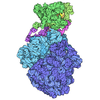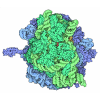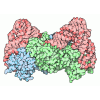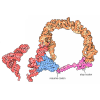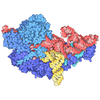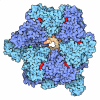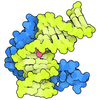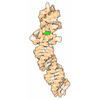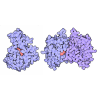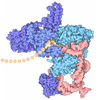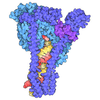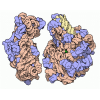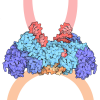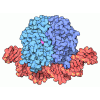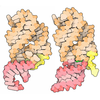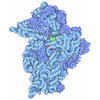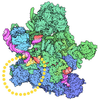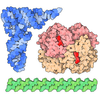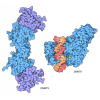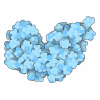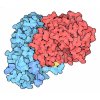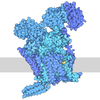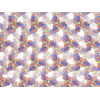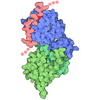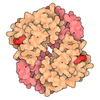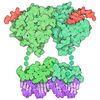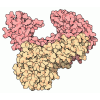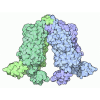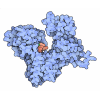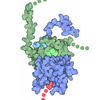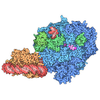+ Open data
Open data
- Basic information
Basic information
| Entry | Database: PDB / ID: 8w2z | |||||||||||||||||||||||||||
|---|---|---|---|---|---|---|---|---|---|---|---|---|---|---|---|---|---|---|---|---|---|---|---|---|---|---|---|---|
| Title | Cas9d 6bp R-loop Seed Complex | |||||||||||||||||||||||||||
 Components Components |
| |||||||||||||||||||||||||||
 Keywords Keywords | IMMUNE SYSTEM/RNA/DNA / CRISPR-Cas9 / Endonuclease / Binary Complex / Effector / sgRNA / IMMUNE SYSTEM-RNA-DNA complex | |||||||||||||||||||||||||||
| Function / homology |  Function and homology information Function and homology information | |||||||||||||||||||||||||||
| Biological species |  Deltaproteobacteria (d-proteobacteria) Deltaproteobacteria (d-proteobacteria) Escherichia phage Lambda (virus) Escherichia phage Lambda (virus) | |||||||||||||||||||||||||||
| Method | ELECTRON MICROSCOPY / single particle reconstruction / cryo EM / Resolution: 3.37 Å | |||||||||||||||||||||||||||
 Authors Authors | Fregoso Ocampo, R. / Bravo, J.P.K. / Taylor, D.W. | |||||||||||||||||||||||||||
| Funding support |  United States, 1items United States, 1items
| |||||||||||||||||||||||||||
 Citation Citation |  Journal: Nat Commun / Year: 2025 Journal: Nat Commun / Year: 2025Title: DNA targeting by compact Cas9d and its resurrected ancestor. Authors: Rodrigo Fregoso Ocampo / Jack P K Bravo / Tyler L Dangerfield / Isabel Nocedal / Samatar A Jirde / Lisa M Alexander / Nicole C Thomas / Anjali Das / Sarah Nielson / Kenneth A Johnson / ...Authors: Rodrigo Fregoso Ocampo / Jack P K Bravo / Tyler L Dangerfield / Isabel Nocedal / Samatar A Jirde / Lisa M Alexander / Nicole C Thomas / Anjali Das / Sarah Nielson / Kenneth A Johnson / Christopher T Brown / Cristina N Butterfield / Daniela S A Goltsman / David W Taylor /   Abstract: Type II CRISPR endonucleases are widely used programmable genome editing tools. Recently, CRISPR-Cas systems with highly compact nucleases have been discovered, including Cas9d (a type II-D nuclease). ...Type II CRISPR endonucleases are widely used programmable genome editing tools. Recently, CRISPR-Cas systems with highly compact nucleases have been discovered, including Cas9d (a type II-D nuclease). Here, we report the cryo-EM structures of a Cas9d nuclease (747 amino acids in length) in multiple functional states, revealing a stepwise process of DNA targeting involving a conformational switch in a REC2 domain insertion. Our structures provide insights into the intricately folded guide RNA which acts as a structural scaffold to anchor small, flexible protein domains for DNA recognition. The sgRNA can be truncated by up to ~25% yet still retain activity in vivo. Using ancestral sequence reconstruction, we generated compact nucleases capable of efficient genome editing in mammalian cells. Collectively, our results provide mechanistic insights into the evolution and DNA targeting of diverse type II CRISPR-Cas systems, providing a blueprint for future re-engineering of minimal RNA-guided DNA endonucleases. | |||||||||||||||||||||||||||
| History |
|
- Structure visualization
Structure visualization
| Structure viewer | Molecule:  Molmil Molmil Jmol/JSmol Jmol/JSmol |
|---|
- Downloads & links
Downloads & links
- Download
Download
| PDBx/mmCIF format |  8w2z.cif.gz 8w2z.cif.gz | 217 KB | Display |  PDBx/mmCIF format PDBx/mmCIF format |
|---|---|---|---|---|
| PDB format |  pdb8w2z.ent.gz pdb8w2z.ent.gz | 159 KB | Display |  PDB format PDB format |
| PDBx/mmJSON format |  8w2z.json.gz 8w2z.json.gz | Tree view |  PDBx/mmJSON format PDBx/mmJSON format | |
| Others |  Other downloads Other downloads |
-Validation report
| Summary document |  8w2z_validation.pdf.gz 8w2z_validation.pdf.gz | 1.2 MB | Display |  wwPDB validaton report wwPDB validaton report |
|---|---|---|---|---|
| Full document |  8w2z_full_validation.pdf.gz 8w2z_full_validation.pdf.gz | 1.2 MB | Display | |
| Data in XML |  8w2z_validation.xml.gz 8w2z_validation.xml.gz | 35.9 KB | Display | |
| Data in CIF |  8w2z_validation.cif.gz 8w2z_validation.cif.gz | 53.1 KB | Display | |
| Arichive directory |  https://data.pdbj.org/pub/pdb/validation_reports/w2/8w2z https://data.pdbj.org/pub/pdb/validation_reports/w2/8w2z ftp://data.pdbj.org/pub/pdb/validation_reports/w2/8w2z ftp://data.pdbj.org/pub/pdb/validation_reports/w2/8w2z | HTTPS FTP |
-Related structure data
| Related structure data | 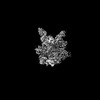 43760MC 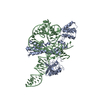 8w2sC 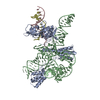 9aufC M: map data used to model this data C: citing same article ( |
|---|---|
| Similar structure data | Similarity search - Function & homology  F&H Search F&H Search |
- Links
Links
- Assembly
Assembly
| Deposited unit | 
|
|---|---|
| 1 |
|
- Components
Components
| #1: Protein | Mass: 86568.711 Da / Num. of mol.: 1 Source method: isolated from a genetically manipulated source Source: (gene. exp.)  Deltaproteobacteria (d-proteobacteria) / Gene: A2022_01700 / Production host: Deltaproteobacteria (d-proteobacteria) / Gene: A2022_01700 / Production host:  |
|---|---|
| #2: RNA chain | Mass: 50836.031 Da / Num. of mol.: 1 Source method: isolated from a genetically manipulated source Source: (gene. exp.)  Deltaproteobacteria (d-proteobacteria) / Production host: Deltaproteobacteria (d-proteobacteria) / Production host:  |
| #3: DNA chain | Mass: 16865.783 Da / Num. of mol.: 1 / Source method: obtained synthetically / Source: (synth.)  Escherichia phage Lambda (virus) Escherichia phage Lambda (virus) |
| #4: DNA chain | Mass: 4313.830 Da / Num. of mol.: 1 / Source method: obtained synthetically / Source: (synth.)  Escherichia phage Lambda (virus) Escherichia phage Lambda (virus) |
| Has protein modification | N |
-Experimental details
-Experiment
| Experiment | Method: ELECTRON MICROSCOPY |
|---|---|
| EM experiment | Aggregation state: PARTICLE / 3D reconstruction method: single particle reconstruction |
- Sample preparation
Sample preparation
| Component | Name: Cas9d:sgRNA:DNA / Type: COMPLEX / Entity ID: all / Source: MULTIPLE SOURCES |
|---|---|
| Source (natural) | Organism:  Deltaproteobacteria (d-proteobacteria) / Strain: NICO DE3 Deltaproteobacteria (d-proteobacteria) / Strain: NICO DE3 |
| Source (recombinant) | Organism:  |
| Buffer solution | pH: 7.9 |
| Specimen | Embedding applied: NO / Shadowing applied: NO / Staining applied: NO / Vitrification applied: YES |
| Vitrification | Cryogen name: ETHANE |
- Electron microscopy imaging
Electron microscopy imaging
| Experimental equipment |  Model: Titan Krios / Image courtesy: FEI Company |
|---|---|
| Microscopy | Model: FEI TITAN KRIOS |
| Electron gun | Electron source:  FIELD EMISSION GUN / Accelerating voltage: 300 kV / Illumination mode: FLOOD BEAM FIELD EMISSION GUN / Accelerating voltage: 300 kV / Illumination mode: FLOOD BEAM |
| Electron lens | Mode: BRIGHT FIELD / Nominal defocus max: 2500 nm / Nominal defocus min: 1500 nm |
| Image recording | Electron dose: 80 e/Å2 / Film or detector model: GATAN K3 (6k x 4k) |
- Processing
Processing
| EM software | Name: PHENIX / Category: model refinement | ||||||||||||||||||||||||
|---|---|---|---|---|---|---|---|---|---|---|---|---|---|---|---|---|---|---|---|---|---|---|---|---|---|
| CTF correction | Type: PHASE FLIPPING AND AMPLITUDE CORRECTION | ||||||||||||||||||||||||
| 3D reconstruction | Resolution: 3.37 Å / Resolution method: FSC 0.143 CUT-OFF / Num. of particles: 70093 / Symmetry type: POINT | ||||||||||||||||||||||||
| Refine LS restraints |
|
 Movie
Movie Controller
Controller





 PDBj
PDBj